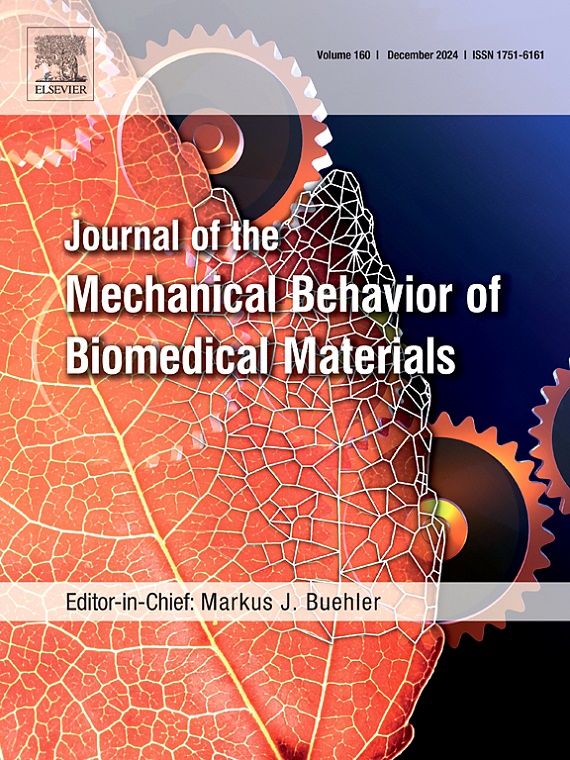Identification of heel pad thickness and visco-hyperelastic properties by finite element analysis and Gaussian process regression
IF 3.3
2区 医学
Q2 ENGINEERING, BIOMEDICAL
Journal of the Mechanical Behavior of Biomedical Materials
Pub Date : 2025-07-02
DOI:10.1016/j.jmbbm.2025.107119
引用次数: 0
Abstract
The importance of the heel pad thickness and visco-hyperelastic material properties on gait and quality of life is clear to biomedical engineers and physicians alike. To this end, this contribution presents first an experimental methodology to measure the load-time response on the heel pad by indentation test. Afterward, finite element analysis (FEA) simulations were implemented to replicate the experimental environment and employed for the training of a Gaussian Process Regression (GPR) model, subsequently employed to estimate the hyperelastic model constants and the heel pad thickness. A second-order polynomial strain energy potential was employed in the FEA models, whereas the viscoelastic behavior was modeled with a stretched exponential formulation. The trained GPR model was tested against experimental results on 6 subjects of different ages and genders, where the visco-hyperelastic properties and heel pad thickness were determined. The predicted heel pad thickness was validated by ultrasonography. The results show that the developed methodology allows for real-time estimation (within 10 s) of the visco-elastic material properties and thickness of the heel pad with comparable accuracy to the established models, thus granting a significant reduction in the computation time with no loss in accuracy.
利用有限元分析和高斯过程回归识别鞋垫厚度和粘超弹性性能
对于生物医学工程师和医生来说,鞋垫厚度和粘弹性材料性能对步态和生活质量的重要性是显而易见的。为此,本文首先提出了一种实验方法,通过压痕试验来测量鞋跟垫的载荷-时间响应。随后,采用有限元分析(FEA)模拟来复制实验环境,并用于高斯过程回归(GPR)模型的训练,随后用于估计超弹性模型常数和鞋跟垫厚度。有限元模型采用二阶多项式应变能势模型,粘弹性模型采用拉伸指数模型。将训练好的GPR模型与6名不同年龄和性别的受试者的实验结果进行对比测试,确定了粘超弹性性能和跟垫厚度。通过超声检查验证了预测的鞋垫厚度。结果表明,所开发的方法允许实时估计(在10秒内)粘弹性材料性能和鞋垫厚度,其精度与已建立的模型相当,从而在不损失精度的情况下显着减少计算时间。
本文章由计算机程序翻译,如有差异,请以英文原文为准。
求助全文
约1分钟内获得全文
求助全文
来源期刊

Journal of the Mechanical Behavior of Biomedical Materials
工程技术-材料科学:生物材料
CiteScore
7.20
自引率
7.70%
发文量
505
审稿时长
46 days
期刊介绍:
The Journal of the Mechanical Behavior of Biomedical Materials is concerned with the mechanical deformation, damage and failure under applied forces, of biological material (at the tissue, cellular and molecular levels) and of biomaterials, i.e. those materials which are designed to mimic or replace biological materials.
The primary focus of the journal is the synthesis of materials science, biology, and medical and dental science. Reports of fundamental scientific investigations are welcome, as are articles concerned with the practical application of materials in medical devices. Both experimental and theoretical work is of interest; theoretical papers will normally include comparison of predictions with experimental data, though we recognize that this may not always be appropriate. The journal also publishes technical notes concerned with emerging experimental or theoretical techniques, letters to the editor and, by invitation, review articles and papers describing existing techniques for the benefit of an interdisciplinary readership.
 求助内容:
求助内容: 应助结果提醒方式:
应助结果提醒方式:


